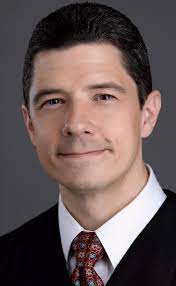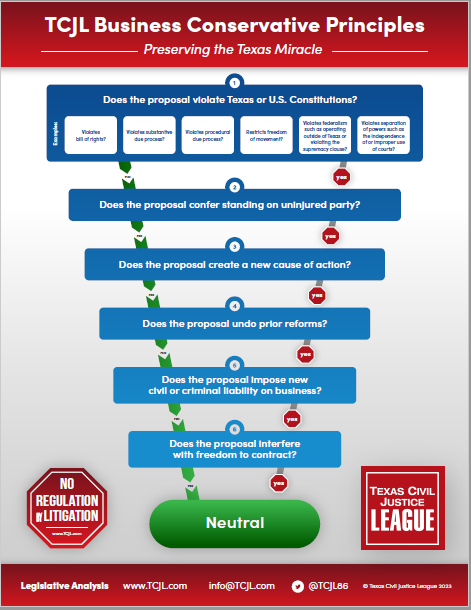
Justice Brett Busby
The Texas Supreme Court has reversed a Houston [14th] Court of Appeals decision holding that a hospital had a duty to an employee who was killed crossing a county road that fronted the hospital.
HNMC, Inc. v. Francis S. Chan, Individually and as Personal Representative of the Estate of Leny Rey Chan, Jonathan Chan, and Justin Chan stemmed from a fatal accident in which a nurse employed by HNMC was struck by a vehicle while crossing the street in front of the hospital in order to access the employee parking lot on the opposite side. While there are crosswalks connecting the hospital to the parking lot’s pedestrian gates, they are located at each end of the block, whereas the hospital entrance is in the middle of the block. Consequently, employees and others frequently cross the road directly to the lot, as occurred here (the county had abandoned a crosswalk in the middle of the block in 2011). Between 2008 and 2012, several accidents between vehicles and pedestrians occurred at that location, leading the hospital to request the county to implement safety measures. The county did nothing, except recommend that the hospital take additional safety measures, which it did not. In 2015 the nurse was killed when a driver pulled out of the parking lot and struck her.
The nurse’s estate and surviving family members sued the driver and the driver’s employer for negligence. The employer designated the hospital and Harris County as responsible third parties, and plaintiffs added the hospital as a defendant. The case went to trial, and the jury found the driver 40% responsible, Harris County 30%, the hospital 20%, and the nurse 10%. The trial court rendered judgment on the verdict. Plaintiffs settled with the driver and the employer, but the hospital appealed. A panel of the court of appeals initially held that the hospital owed no duty, but the court granted reconsideration en banc and affirmed the trial court’s judgment by a 5-4 vote. While acknowledging the general rule that “property owners owe no duty to make safe public roadways adjacent to their property, the majority “recognized a new duty specific to this situation by analyzing the factors listed in Greater Houston Transportation Co. v. Phillips [801 S.W.2d 523, 525 (Tex. 1990)].” The hospital sought review, which SCOTX granted.
In an opinion by Justice Busby, SCOTX reversed. The Court had to determine “whether certain recognized duty or no-duty rules apply to these circumstances.” Only if those rules do not apply may a court consider recognizing a new duty. Here the Court determined that existing rules applied. First, a property generally “has no duty to ensure the safety of a person who leaves the owner’s property and suffers an injury on an adjacent public roadway, or to ensure that person’s safety against the dangerous acts of a third party.” Most of the so-called “exceptions” to the general rule, Justice Busby noted, “do not directly address duties on public roads, so they are not truly exceptions to the background no-duty rule.” These types of cases include: (1) a duty “owed by a party who ‘undertakes to make [a] premises safe for others’” (citation omitted); (2) “the duty owed by a landowner whose land contains a dangerous condition or excavation appurtenant to a public highway” (citation omitted); (3) “the duty owed by a property owner or occupier who assumes actual control of adjancent property” (citation omitted); and (4) “the duty owed by a property owner or occupier who knows of an obscured danger near the entrance or exit of this property” (citation omitted).
While the court of appeals correctly set out these special rules, Justice Busby observed, it erred by not analyzing them. Instead, the court of appeals improperly applied the Phillips factors because “[t]he Phillips factors are inapplicable in cases where there is a duty rule that takes the factual circumstances at issue into account” (citations omitted). Even so, Phillips can “only be used to identify a class of cases in which a duty exists, not to craft a duty tailored to the unique facts of an individual case.” Here the general no-duty rule applied to the facts, ruling out the use of Phillips at the outset. Consequently, Justice Busby turned to an analysis each of the four special cases quoted above, determining that the hospital owed a limited duty over the public right-of-way only to the extent that it constructed a conrete pad next to the street, a driveway over the right-of-way on the opposite side for vehicles traveling between the parking lot and street, and traffic control signs in the right-of-way next to the driveway. The hospital thus owed a duty to “address any dangerous conditions in thoselimited areas of the right-of-way where it actually exercised control.”
Plaintiff argued that the jury’s finding that the hospital was negligent supports the judgment in her favor and that, by objecting to the submission of a premises liability charge, defendant “invited” error (the court of appeals went for this “invited error” theory). Examining the jury charge, Justice Busby determined that it “failed to include the essential elements of a premises liability claim.” In her dissent from the majority opinion of the court of appeals, Chief Justice Christopher contended that plaintiff had the obligation “to ensure that a charge sufficient for her theory of liability was submitted to the jury, and [defendant] was underno obligation to object to the incorrect submissions.” Because defendant failed to raise the “invited error” issue in SCOTX, the Court did not address it. Instead, defendant asserted that plaintiff failed to provide evidence of breach of duty and proximate cause. SCOTX agreed, concluding “that no reasonable jury could find that the areas of public right-of-way controlled by [defendant] included unreasonably dangerous conditions that proximately caused [decedent’s] death. Ultimately, the hazard [decedent] faced was a careless driver on Cali drive: a hazard for which [defendant] was not responsible in an area where it had not exercised control.” SCOTX reversed the court of appeals and rendered a take-nothing judgment for the hospital.












